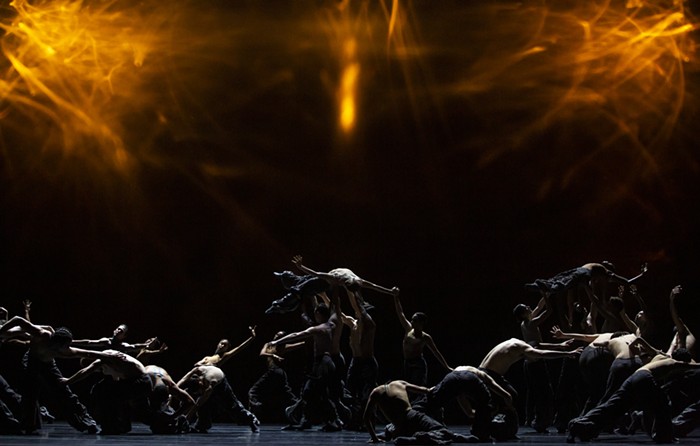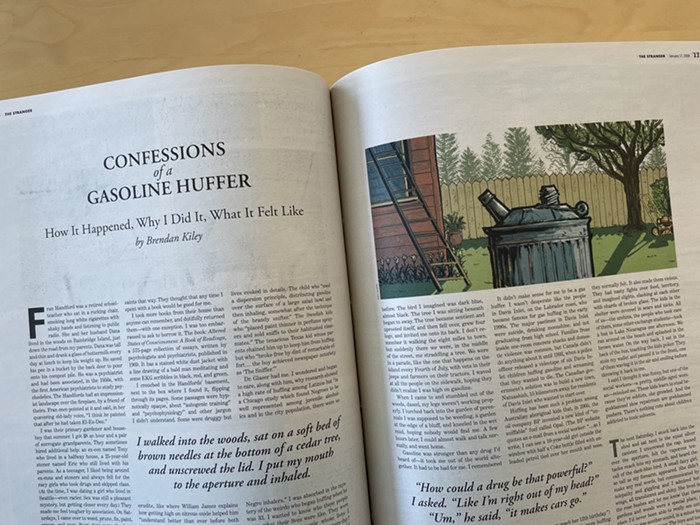A Contemporary Theatre, 292-7676.
Through Nov 11. Warning: This review may reveal secrets.
Playwright W. David Hancock wants to radically reinvent theater. He tosses aside conventional actor-audience relationships and subverts expectations of plot. For example, the audience for The Race of the Ark Tattoo enters a large room filled with stuff for sale--tile samples, old magazines, recipe holders, discarded toys. A quirky guy named P. Foster (Matthew Maher) presides over this flea market and will happily sell you anything there. After the audience mills around a bit, everyone takes a chair from a stack and listens to Foster deliver a lecture, or more accurately a series of anecdotes sparked by items the audience selects (thus the show is different every night). Once a story has been told about each object, the play invites you to see it in a different light--not as an inert thing, but as an artifact, still resonant with the lingering desires and fears of those who used it.
Throughout the stories and in between them, Foster makes comments about his foster father, Homer Phinney, to whom most of this junk once belonged. (Foster more or less channels Phinney periodically, telling stories in the older man's voice.) These clues and suggestions never cohere into a story about their relationship--for that matter, many of the "stories" are simply fragments or snapshots--but they do, over the course of the evening, create what one might call an emotional blind spot, which drives the urge to tell all these stories and yet cannot, itself, be described. Some may find this unsatisfying, arguing that it's the playwright's job to resolve a play, not the audience's. But I suspect that much of our lives are shaped by such blind spots--that the accumulation of our experiences creates forces that can't be ascribed to individual moments, and so can't be seen or grasped in any conventional way. Ark Tattoo tackles the challenge of describing the invisible, and probably doesn't succeed; but the delight on the faces of the audience suggests that the challenge is not a chore. BRET FETZER
The Primary English Class
Bridges International Repertory Theatre at Richard Hugo House,
325-6500. Through Nov 11.
There's good news and bad news. First the bad: If a character is penned to behave in ways that are nothing like what a rational human being would do in the same situation, well, there's just nothing an actor can do to compensate for it. See, modern actors are taught to find internal emotional motivations for every action and word. Therefore, if their character is acting like an apoplectic lunatic, but isn't an apoplectic lunatic (and therefore has little or no rational, believable motivation to be doing so), well guess what? An actor--no matter how good--has no choice but to play a deranged, apoplectic lunatic for no rational, believable reason. It is very irritating to sit through for two hours.
Picture it: A Kraut, a Jap, a Wop, a Chink, and a Frenchie. Each speaks only their native tongue. They're tossed together in their first English as a Second Language class. On one side of the stage, a woman in ancient garb translates for the audience. Enter the ditzy American "teacher" (her first teaching gig--it shows), and wackiness ensues. But not always the best kind of wacky: copious boob grabbing, physical assaults on sweet old Chinese women, mad assumptions, and irrational gags. And that's the trouble--why would anyone put up with this crap and stay in that classroom for even a minute? I have no idea.
So, the good news? I liked it anyway. Why? The cast was so damn talented and fun, that's why. They made this rather goofy play entertaining and fun by sheer force of will. The men were great, but the women--from the impressive translator to adorable old Mrs. Pong--were so cute and charismatic you could just eat 'em with a spoon! I may have walked away rolling my eyes, but I was smiling too. ADRIAN RYAN
Shockheaded Peter
The Moore Theatre, 292-2787.
Through Nov 4.
"We must be cruel to be kind," declares Julian Bleach, the master of ceremonies for this macabre cabaret. "And sometimes we must be cruel for recreational purposes." That pretty much sums up this ingenious amalgamation of puppetry, song, music-hall theatrics, and dark wit. Based on Struwwelpeter, an 1844 children's book by Heinrich Hoffmann, Shockheaded Peter frolics from tale to tale of small children being burned, bitten, starved, scissored, and so on, presented in a mix of energetic songs (aggressively shrieked by countertenor Martyn Jacques, fronting musical trio the Tiger Lillies) and theatrical vignettes. The only material not taken directly from Hoffmann is the story that frames the entire piece, that of the title character's parents, who sink into drunkenness and melancholia after stuffing their grotesque offspring under the floorboards. While it was probably wise to insert some kind of through line into this series of unrelated episodes, this material--generated by the British creators of the show--descends more from disapproving Victorian morality tales, and lacks the sadistic glee of the original Germanic rhymes.
At the show's end, Bleach proclaims that there is a moral to all this malice, but having a point is pretty much beside the point; Shockheaded Peter is, more than anything else, a glorious exercise in style. The team behind this show cared much more about the washed-out red of Bleach's stockings than about why we revel in this vicious mayhem, or what such delight might say about our culture (or Hoffmann's). So there's something not wholly satisfying about the show, delicious as it is; but the design, the music, and above all Bleach's outstanding performance--delicate, jaded, baroquely malevolent--make it a sensual treat. BRET FETZER












